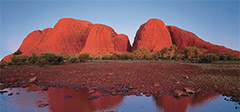Uluru
Uluru is one of Australia's most famous natural landmarks. The sandstone formation stands 348 m (1,142 ft) high, rising 863 m (2,831 ft) above sea level with most of its bulk lying underground, and has a total circumference of 9.4 km (5.8 mi).
Uluru was named Ayers Rock, in honour of the Chief Secretary of South Australia, Sir Henry Ayers. On 15 December 1993, it was renamed "Ayers Rock / Uluru" and became the first official dual-named feature in the Northern Territory. On 6 November 2002 the name reversed to "Uluru / Ayers Rock"
Uluru is more than just a rock, it is a living cultural landscape that of which is considered sacred to the Yankunytjatjara and Pitjantjatjara people. These people of the land are the traditional landowners and guardians of the Uluru Kata Tjuta National Park
Kata Tjuta and Uluru are the two major features of the Uluṟu Kata Tjuṯa National Park the park covers 132600 hectares and has springs, waterholes, rock caves, and ancient paintings.
Climbing Uluru is now prohibited, the Anangu ask as visitors to their land that you respect their wishes, culture and law by not climbing Uluru. The path of the climb is associated with important Mala ceremonies.
































